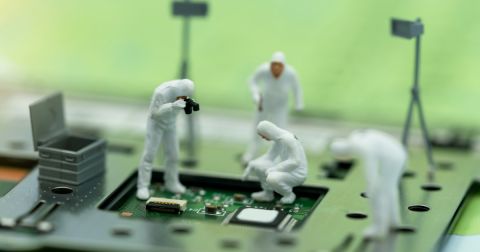

Build Smarter. Faster. Get up to 30% Off!
Work smarter across teams with integrated tools that reduce delays.
Managing Electronic Component Obsolescence: Practical Insights for Engineering Managers

The acceleration of technological innovation, the complexity of global supply chains, and emerging environmental and safety regulations have dramatically increased the likelihood of critical components becoming obsolete during a product's lifecycle. Raw material shortages and supplier bankruptcies further contribute to increased electronic component obsolescence. For engineering managers, proactively managing obsolescence risk is essential to avoid costly redesigns, supply chain breakdowns, and system failures.
Besides cost and service implications, using obsolete or near-obsolete components can compromise quality and performance. In sectors like defense and aerospace, which demand high reliability and safety, such failures could result in mission-critical consequences or even risks to national security. Sustaining access to inventory of high-quality parts over long product lifecycles adds another layer of complexity.
Below, we provide some strategies, best practices, and component obsolescence management tools to help manage this complexity and avoid the logistical challenges and risks that come from obsolete components.
1. Implement Proactive Electronic Component Lifecycle Management
A proactive approach to electronic component lifecycle management is essential for mitigating the risk of obsolescence. PCB designers must maintain supply chain visibility throughout the design process to avoid costly redesigns.
However, given the sheer volume of components and level of supply chain visibility required for risk mitigation and proactive decision-making, companies must adopt component obsolescence management tools that enable them to easily access necessary data and monitor the lifecycle status of components from procurement through to end-of-life (EOL).
Specialized software solutions like Altium's ActiveBOM can streamline the process of managing component obsolescence, helping engineering managers to integrate component selection with lifecycle management by providing real-time updates on component availability, pricing, and lifecycle status, ensuring they can identify potential obsolescence risks early.
Tools like ActiveBOM seamlessly integrate with the design process, helping engineers identify components at risk of becoming obsolete and offering alternative options. They also allow companies to track where specific components are used across multiple products, making it easier to manage obsolescence risks across an entire product portfolio.
ActiveBOM (Bill of Materials Management)
ActiveBOM is a feature within Altium Designer that helps engineers manage the Bill of Materials (BOM) in real time, providing:
- Real-time component data: ActiveBOM automatically pulls up-to-date information on components such as availability, pricing, and lifecycle status directly from suppliers.
- Risk mitigation: It flags components that are obsolete or at risk of becoming unavailable, allowing you to make proactive decisions.
- Alternatives and sourcing: ActiveBOM suggests alternative components based on the current market situation and helps optimize costs and supply chain risks.
- BOM validation: ActiveBOM validates that the selected components are correct and meet design requirements, helping to reduce errors and ensure smoother manufacturing.
2. Gain Supply Chain Visibility Early in the Design Process
Addressing the PCB component supply chain early in the design phase is the most effective way to avoid costly redesigns when parts become obsolete. By identifying parts nearing the end of their lifecycle, you can adjust your sourcing strategy accordingly, ensuring that the components you select remain available when your board is ready for manufacturing.
Altium 365 simplifies the process of managing electronic component obsolescence by directly integrating supplier and lifecycle data into Altium Designer through the Manufacturer Part Search panel. This feature provides real-time access to verified parts, sourcing details, and downloadable symbols and footprints while alerting designers to obsolete components. Seamless integration between Altium Designer and Altium 365 offers a comprehensive solution for managing component obsolescence throughout the entire design process, ensuring a smoother transition from design to production.
Altium 365 (Cloud Collaboration Platform)
Altium 365 is a cloud-based platform designed to streamline collaboration across the PCB design and manufacturing lifecycle. Key features of Altium 365 include:
- Real-time collaboration: Altium 365 enables teams to work on designs simultaneously, regardless of location, by centralizing project data in the cloud.
- Design data management: It securely stores all design files, BOMs, and project data, ensuring version control and easy access to project history.
- Manufacturing integration: The platform allows seamless sharing of design data with manufacturing partners, ensuring that BOMs and design files are always aligned and current.
- Component library synchronization: With Altium 365, design teams can access a unified component library, ensuring all team members use the same approved parts across multiple projects.
Within Altium 365 is the BOM Portal, a centralized tool where a BOM for a new product can be reviewed and used to plan purchases for an upcoming build. Within the BOM Portal is an instant display of component lifecycle status for each line in the BOM thanks to data pulled from industry-leading data sources like SiliconExpert and Z2Data. The BOM Portal also helps users see prices and inventory across distributors, reducing component obsolescence risk and enabling smarter purchasing decisions earlier in the design cycle. Obsolescence management software, powered by reliable and comprehensive data sources, helps engineers make informed decisions to avoid costly redesigns and production delays.

3. Diversify Supply Chains and Secure Long-Term Supplier Relationships
Single-sourcing critical supplies leaves companies vulnerable to obsolescence risk. Engaging multiple suppliers for key components builds redundancy into the supply chain, mitigating the risk of supply disruptions and ensuring flexibility when one manufacturer phases out components. Establishing strong relationships and long-term contracts with these critical suppliers ensures continued access to business-critical components and introduces more opportunities for last-time buys.
When components are nearing the end of their production lifecycle, companies can opt for a last-time buy (LTB) to secure a sufficient quantity of the part for the remainder of the product's lifecycle. However, LTBs come with risks:
Storage and Degradation Risks: Components purchased in bulk may require specialized storage to avoid degradation over time. Moreover, predicting the exact quantity needed for future production can be challenging, potentially leading to shortages or excess inventory.
Cashflow Implications: Bulk purchases can strain budgets, particularly for cash-strapped companies. Strategic planning is essential to ensure that LTBs are a business-wise solution.
4. Maintain Design Flexibility
Designing for flexibility is key to mitigating the impact of obsolescence. Engineers should consider future component replacements during the initial design phase. This can involve:
Design for Redesign: Products intended to have long lifecycles should be designed with future redesigns in mind. This means selecting components with longer projected lifespans and ensuring that the PCB layout accommodates future changes in part availability.
Flexible PCB Layouts: Allowing space for alternative components in PCB designs can make it easier to replace obsolete parts without redesigning entire boards. This approach is particularly handy for complex circuits where critical components might become obsolete.
Another key factor to consider is the cost of the replacement. A direct replacement will often have a similar price, making it a straightforward swap. However, market fluctuations can cause prices to shift unexpectedly. When this happens, the right decision may involve evaluating whether there's flexibility in the design to accommodate a lower-cost component with different specifications. If the design lacks that flexibility, and either the cost becomes too high or a replacement isn't available, you may need to rework the board to accommodate an alternative pin-out or even consider a full redesign. Managing BOM revision control and rework documentation can quickly become complex in these situations, though the right software tools can help streamline the process.
5. Leverage Alternative Sourcing Options
When a component becomes obsolete, businesses must explore alternative sourcing strategies to avoid production delays. Key approaches include:
Finding Drop-in Replacements: A direct replacement for an obsolete component may not exist in some cases, but similar components might be available. Engineers should carefully evaluate how these alternatives will affect system performance and whether adjustments to the design are necessary.
Reverse Engineering and Redesign: For critical components without suitable replacements, reverse engineering might be necessary. This involves redesigning the product to accommodate newer components, which can be costly and time-consuming.
6. Developing a Comprehensive Electronic Component Obsolescence Management Plan
Ultimately, managing electronic component obsolescence requires a comprehensive plan that spans the entire product lifecycle, including:
Risk Assessment: Regularly assessing the risk of obsolescence for all critical components, particularly for products with long lifecycles.
Cross-Department Collaboration: Teams across engineering, procurement, and supply chain management should collaborate to ensure that everyone is aware of potential obsolescence risks and can work together to develop solutions.
Continuous Monitoring and Updating: Obsolescence management should be an ongoing process, with continuous monitoring of component lifecycles and proactive updates to the obsolescence management plan.
Altium 365 BOM Portal makes it easier for electronic development projects to share component data—including electronic component obsolescence data—with all project stakeholders, whether electrical engineers, engineering managers, procurement professionals, or manufacturers.

7. Maintain Clean Schematics
Cluttered or unreadable PCB schematics can lead to numerous component management problems. This is especially true for passive parts, which are particularly vulnerable to oversight due to their small size. These components can often be incorrectly labeled or poorly marked, and because they are frequently part of standard circuits, errors can easily be replicated across new designs. To prevent these issues from spreading, it's essential to ensure that all parts from legacy designs—including small passive components—are clearly labeled and easily identifiable.
8. Conduct Thorough, Iterative Bom Reviews, Especially For Copied Circuitry
Reusing existing circuitry can save time and leverage proven design elements, but it also comes with risks. Without a proper process to monitor these designs, you may inadvertently rely on components nearing obsolescence. Just one obsolete part can quickly erase the time savings you gained. It's important to take a step back and thoroughly review any copied circuitry to ensure all components are still viable.
9. Audit Existing BOMs For Critical Information
Older designs may lack the essential data needed for effective sourcing. To avoid potential issues, reviewing BOMs from legacy projects is crucial, ensuring that they are accurate and complete. This allows for the sourcing of alternative components that meet all form, fit, and function requirements.
10. Consider Hiring an Obsolescence Manager
Lastly, appointing a dedicated obsolescence manager can be crucial to mitigating the risks associated with obsolete parts. This role focuses on procuring and managing electronic components, spare parts, and raw materials. Their responsibilities should encompass monitoring and addressing unforeseen spikes in demand, raw material shortages and scarcity of parts, lifecycle risks of key parts, and component turnover.
A successful obsolescence manager should cultivate strong relationships with distributors while staying informed about supply and demand fluctuations. They must also anticipate potential disruptions, such as the effects of mergers and acquisitions on supply chains, regulatory changes affecting raw materials, or weather events like typhoons that might disrupt distribution.
Managing electronic component obsolescence is a multifaceted challenge that requires a proactive approach and supportive tools. From electronic components lifecycle management to maintaining flexible designs and diversifying supply chains, businesses can mitigate the risks and costs associated with obsolete components.
Engineering managers can leverage software like Altium 365 and ActiveBOM to adopt best practices in lifecycle management and ensure the longevity and reliability of their products while staying ahead of the curve in an ever-evolving technological landscape.













